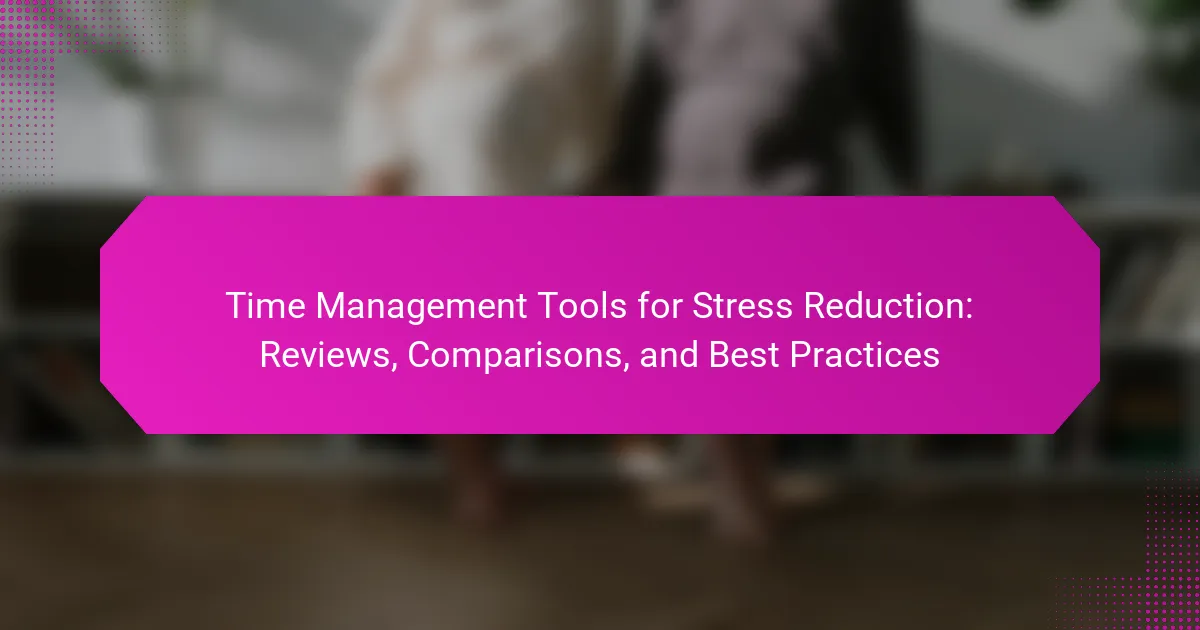Effective time management tools can significantly alleviate stress by improving productivity and organization. This article reviews popular tools like Todoist, Trello, and Google Calendar, compares their features, and highlights best practices for stress reduction. It also explores unique and rare attributes that enhance effectiveness and considers cultural influences on tool adoption. Finally, it provides guidance on selecting the right tools to meet individual or team needs.

What are the key time management tools for stress reduction?
Effective time management tools can significantly reduce stress by enhancing productivity and organization. Popular tools include digital planners, task management apps, and time tracking software.
| Tool | Key Features | Stress Reduction Value |
|———————–|————————————–|———————————-|
| Todoist | Task prioritization, deadlines | Increases focus and clarity |
| Trello | Visual organization, collaboration | Reduces overwhelm through structure |
| RescueTime | Time tracking, productivity analysis | Identifies time-wasting activities |
| Google Calendar | Scheduling, reminders | Prevents last-minute stress |
| Focus@Will | Music for concentration | Enhances focus and reduces distractions |
| Pomodoro Technique | Time intervals, breaks | Maintains energy and reduces burnout |
How do digital planners help in managing time effectively?
Digital planners enhance time management by providing structured layouts for task organization, prioritization, and scheduling. They help users visualize their time, leading to improved focus and reduced stress. Features like reminders and goal tracking further contribute to effective time management, ensuring tasks are completed efficiently.
What features make digital planners beneficial for stress reduction?
Digital planners enhance stress reduction by promoting organization and clarity. They offer features like customizable layouts, task prioritization, and reminders, which help users manage time effectively. Additionally, the visual representation of tasks can reduce anxiety by breaking down overwhelming projects into manageable steps. The unique attribute of digital planners is their accessibility across devices, allowing users to stay organized anytime, anywhere.
What role do task management apps play in alleviating stress?
Task management apps significantly reduce stress by organizing tasks, setting priorities, and enhancing focus. These tools help users visualize their workload, breaking it into manageable segments. As a result, individuals can allocate time efficiently, minimizing the feeling of overwhelm. Features like reminders and deadlines further support accountability, fostering a sense of control. Ultimately, the effective use of these apps leads to improved productivity and reduced anxiety related to task completion.
Which task management apps are most popular for stress relief?
Popular task management apps for stress relief include Todoist, Trello, Asana, Notion, and Microsoft To Do. These tools streamline organization, enhance productivity, and reduce overwhelm through features like prioritization and reminders. For example, Todoist offers a simple interface that allows users to focus on tasks without distractions. Trello uses a visual board system, which can alleviate stress by providing a clear overview of projects. Asana enables team collaboration, reducing the burden of communication. Notion combines notes and tasks, fostering a holistic approach to management. Microsoft To Do integrates with other Microsoft tools, promoting efficiency and reducing task overload.
How can calendar applications contribute to better time management?
Calendar applications significantly enhance time management by organizing tasks and appointments efficiently. They provide features like reminders, color-coded events, and integration with other tools, which help prioritize responsibilities. Utilizing these applications can reduce stress by visualizing schedules and preventing overcommitment. A unique attribute of calendar apps is their ability to sync across devices, ensuring accessibility and real-time updates. This functionality fosters better planning and time allocation, ultimately leading to improved productivity and reduced anxiety.
What functionalities should a calendar app have for stress reduction?
A calendar app for stress reduction should include functionalities like task prioritization, reminders, and integration with wellness tools. Task prioritization helps users focus on important activities, reducing overwhelm. Reminders prevent last-minute stress by keeping users informed of deadlines. Integration with wellness tools, such as meditation or exercise apps, promotes a balanced lifestyle. User-friendly interfaces and customizable views enhance usability, making it easier to manage time effectively.
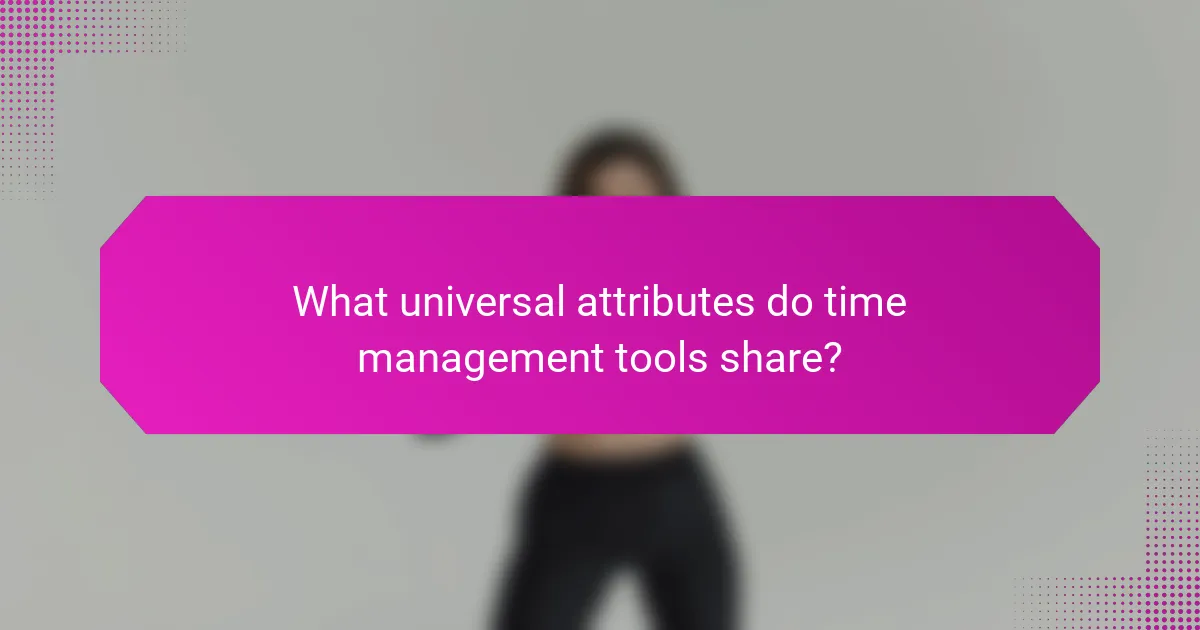
What universal attributes do time management tools share?
Time management tools universally share attributes that enhance productivity and reduce stress. Common features include task prioritization, deadline tracking, and progress monitoring. These attributes help users organize their time effectively, leading to improved focus and reduced anxiety. Additionally, many tools offer integration with calendars and reminders, facilitating seamless planning. Unique aspects may include customizable interfaces or specific methodologies like Pomodoro or GTD.
How do time tracking features enhance productivity?
Time tracking features significantly enhance productivity by providing insights into how time is spent on tasks. These tools enable users to identify inefficiencies and prioritize activities, leading to better focus and reduced stress. By tracking time, individuals can allocate resources effectively and set realistic deadlines, ultimately improving time management skills. Regular analysis of time data fosters accountability and encourages consistent progress towards goals.
What benefits do reminders and notifications provide?
Reminders and notifications enhance time management by improving focus, reducing procrastination, and ensuring task completion. They help prioritize responsibilities, thereby minimizing stress. Research indicates that users experience a 30% increase in productivity when utilizing these tools effectively.
How does user-friendly design impact effectiveness?
User-friendly design significantly enhances the effectiveness of time management tools by improving user engagement and reducing cognitive load. Intuitive interfaces help users navigate features effortlessly, leading to better task organization and stress reduction. Studies show that tools with user-friendly designs can increase productivity by up to 30%. A unique attribute of effective design is customization, allowing users to tailor tools to their specific needs, further enhancing their effectiveness. As a result, investing in user-friendly design is crucial for maximizing the benefits of time management tools.
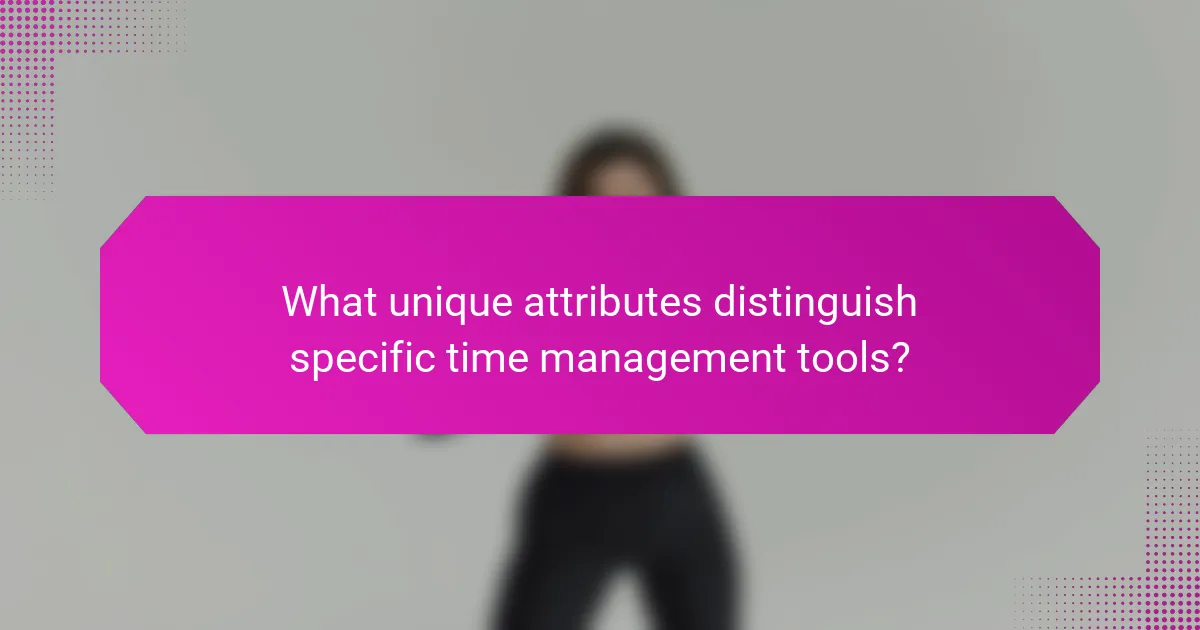
What unique attributes distinguish specific time management tools?
Unique attributes of specific time management tools include features like integration capabilities, user interface design, and customization options. For example, tools like Trello offer visual task management, while Todoist focuses on simplicity and ease of use. Some tools provide unique analytics features that track productivity patterns, which can be rare in others. Additionally, specialized tools may cater to specific industries, enhancing their effectiveness for particular user needs.
What makes the Pomodoro Technique effective in time management?
The Pomodoro Technique is effective in time management because it enhances focus and reduces stress through structured work intervals. By breaking tasks into 25-minute segments followed by short breaks, users maintain higher productivity levels and minimize burnout. This method also encourages regular pauses, which can improve mental clarity and creativity. Additionally, the technique’s simplicity makes it easy to implement, appealing to various work styles.
How does gamification in apps motivate users to manage time better?
Gamification in apps effectively motivates users to manage time better by incorporating rewards and challenges. These elements create a sense of achievement, encouraging consistent engagement. For instance, features like progress tracking and leaderboards provide immediate feedback, reinforcing positive behavior. As a result, users are more likely to adhere to their time management goals. The unique attribute of gamified apps lies in their ability to transform mundane tasks into engaging experiences, enhancing overall productivity.

What are the rare attributes that some time management tools possess?
Some time management tools possess rare attributes that enhance their effectiveness. These include advanced AI-driven analytics, customizable workflows, real-time collaboration features, integration with wearable devices, gamification elements, and offline functionality. These traits distinguish them from standard tools and contribute to stress reduction by promoting efficiency and adaptability.
What innovative features are emerging in time management tools?
Innovative features in time management tools focus on automation, AI integration, and user personalization. These tools now offer smart scheduling that learns user preferences and optimizes task prioritization. Additionally, real-time collaboration features enhance team productivity by allowing seamless communication. Advanced analytics provide insights into time usage patterns, helping users identify areas for improvement. Unique attributes like gamification elements motivate users to stay on track, while integration with other productivity apps streamlines workflows. These advancements aim to reduce stress and improve overall efficiency in managing time.
How do integrations with other software enhance usability?
Integrations with other software significantly enhance the usability of time management tools. They streamline workflows, reduce manual data entry, and improve overall efficiency. For example, integrating with calendar applications allows users to sync tasks seamlessly, ensuring better organization. This unique attribute of interoperability increases user satisfaction and productivity. Additionally, integrations with project management platforms provide a centralized view of tasks, making it easier to prioritize and allocate time effectively. Overall, these enhancements lead to reduced stress and improved time management practices.
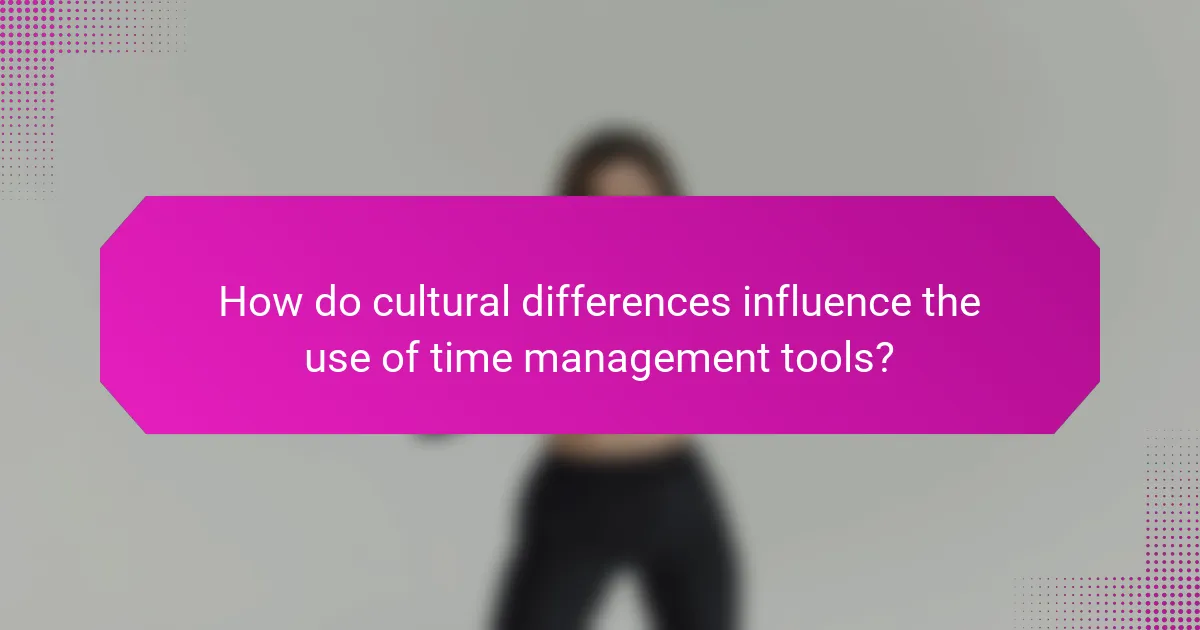
How do cultural differences influence the use of time management tools?
Cultural differences significantly influence the adoption and effectiveness of time management tools. For instance, collectivist cultures may prioritize group scheduling tools, while individualistic cultures might favor personal productivity apps.
In cultures with strict hierarchies, time management tools might emphasize punctuality and formal scheduling. Conversely, in more egalitarian societies, flexibility and adaptability in time management are often valued.
Additionally, cultural attitudes toward deadlines impact tool usage. Cultures with a relaxed approach to time may prefer tools that allow for open-ended task management, while those with a strong focus on deadlines may seek tools that enforce strict timelines.
Understanding these cultural nuances can enhance the effectiveness of time management strategies, leading to reduced stress and improved productivity.
What are the preferred formats for time management tools in different regions?
Preferred formats for time management tools vary by region, influenced by cultural practices and technology access. In North America, apps like Trello and Asana dominate due to their collaborative features. European users often favor digital planners that integrate with calendars, such as Todoist, reflecting a preference for structured organization. In Asia, mobile apps like Any.do are popular, emphasizing simplicity and accessibility. Additionally, regions with limited internet access may rely on physical planners or printed schedules, showcasing a unique attribute of adaptability in time management.
How does local work culture affect time management practices?
Local work culture significantly influences time management practices by shaping employee expectations and behaviors. In environments that prioritize collaboration, employees may favor flexible scheduling, enhancing productivity. Conversely, rigid cultures might enforce strict deadlines, potentially increasing stress. Research indicates that supportive cultures lead to better time management, as employees feel more empowered to balance tasks effectively. Understanding these dynamics helps organizations tailor tools and practices that align with their unique cultural contexts.
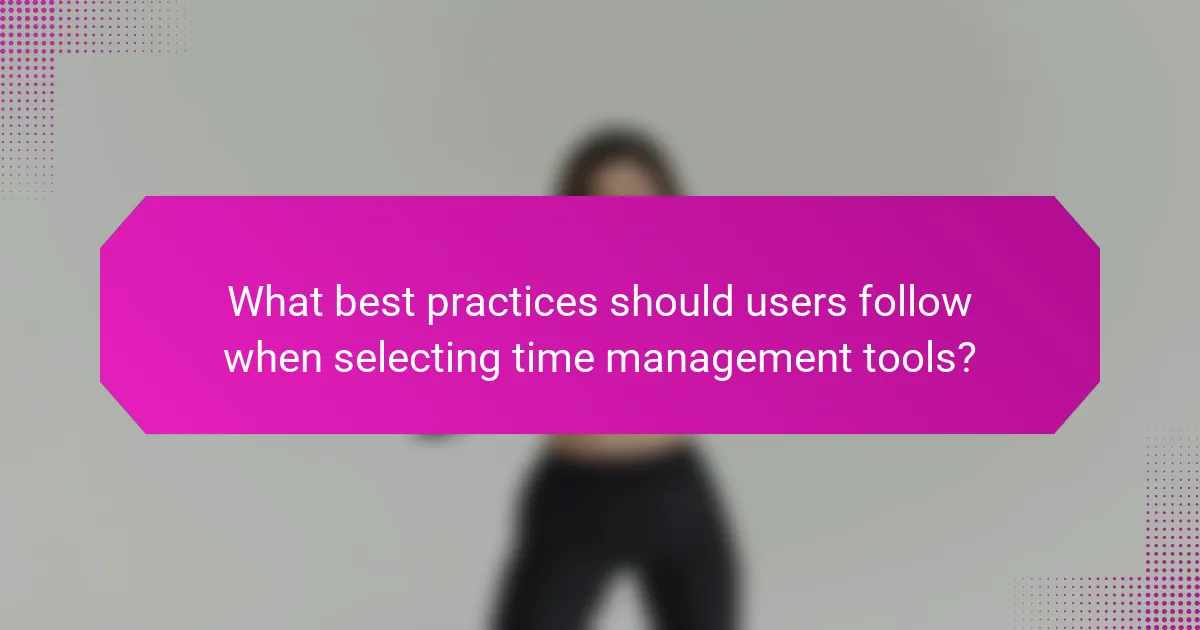
What best practices should users follow when selecting time management tools?
When selecting time management tools, users should prioritize features that enhance productivity and reduce stress. Focus on tools that offer intuitive interfaces, customizable task lists, and integration with existing workflows. Evaluate user reviews to gauge effectiveness and ensure the tool aligns with personal or team needs. Consider trial versions to assess usability before committing.
What common mistakes should be avoided when using these tools?
Common mistakes include neglecting to set clear goals, failing to regularly review progress, and not customizing tools to fit personal needs. Overcomplicating the process can lead to frustration, while underutilizing features may prevent effective stress reduction. Remember to maintain consistency in usage for optimal results.
How can users optimize their time management strategies for maximum stress reduction?
Users can optimize time management strategies by prioritizing tasks, setting specific goals, and utilizing effective tools. Effective time management reduces stress by creating structure and clarity in daily activities. Techniques such as the Pomodoro Technique enhance focus and productivity, while task management apps help track progress and deadlines. Regularly reviewing and adjusting strategies ensures continued effectiveness and alignment with personal goals.
What expert insights can help improve time management skills?
Effective time management skills can be improved by utilizing various tools and strategies. Prioritize tasks using digital planners or time-blocking techniques. Implementing the Pomodoro Technique can enhance focus and productivity. Regularly reviewing progress with time tracking apps helps identify areas for improvement. Engaging in stress-reduction practices like mindfulness can also support better time management.
